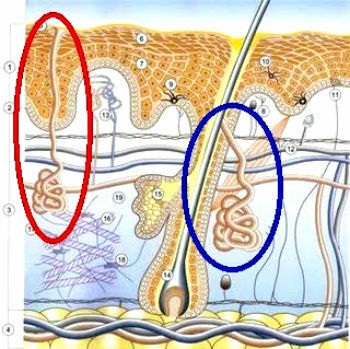The sweat glands are found in almost the entire length of the skin.
They are exocrine glands, responsible for eliminating sweat and consequently for the body's thermoregulation.
The glandular epithelial tissue forms the sweat gland, in which two portions are found:
- Secretor Portion: Coiled structure, consisting of light and dark cells, which release different substances. It is located deep in the skin, being responsible for the production of sweat
- Conductive portion: Made up of basal and superficial cells, it represents a channel that transports sweat to the outside of the body.
Classification
There are two types of sweat glands: eccrine and apocrine.

Eccrine or merocrine sweat glands
Eccrine sweat glands are the most frequent and occur throughout almost the entire length of the skin. However, they concentrate on the palms of the hands and soles of the feet.
these glands release their secretions directly onto the surface of the skin. Furthermore, the secretion lacks part of the cytoplasm of your cells.
The sweat released by the eccrine glands is more diluted. It contains very little protein, in addition to potassium, sodium, urea, ammonia and uric acid.
The eccrine glands are active from an individual's birth.
Apocrine sweat glands
Apocrine sweat glands are larger and less frequent. They are found in the armpits, breast areolas, and in the genital and anal region.
the apocrine glands release their secretions into the channels of hair follicles, unlike the eccrine glands.
Another feature is the presence of parts of the cell's cytoplasm in the secretion released by the gland.
The secretion released by the apocrine glands is more viscous and odorless. The typical odor of sweat is the result of the action of bacteria where it is released.
Apocrine glands become active after puberty.
Read too:
- Glands of the human body
- endocrine glands
- endocrine system
Sweat
Sweat is the odorless liquid released by the sweat glands.
The function of sweat is to cool the body, releasing excess heat and promoting the body's thermoregulation.
The constitution of sweat is mainly water, but urea, uric acid, ammonia, sodium ions, potassium and chlorine are also found.
The sweat glands also eliminate toxic or unnecessary substances from the body. Therefore, some toxins, medications or products of metabolism can be found in sweat.
Curiosities
- There are over two million sweat glands throughout the body.
- We did not find sweat glands in the following parts of the body: lips, clitoris, nipples and glans penis.
Know more:
- Human skin
- epithelial tissue
- Integumentary System


